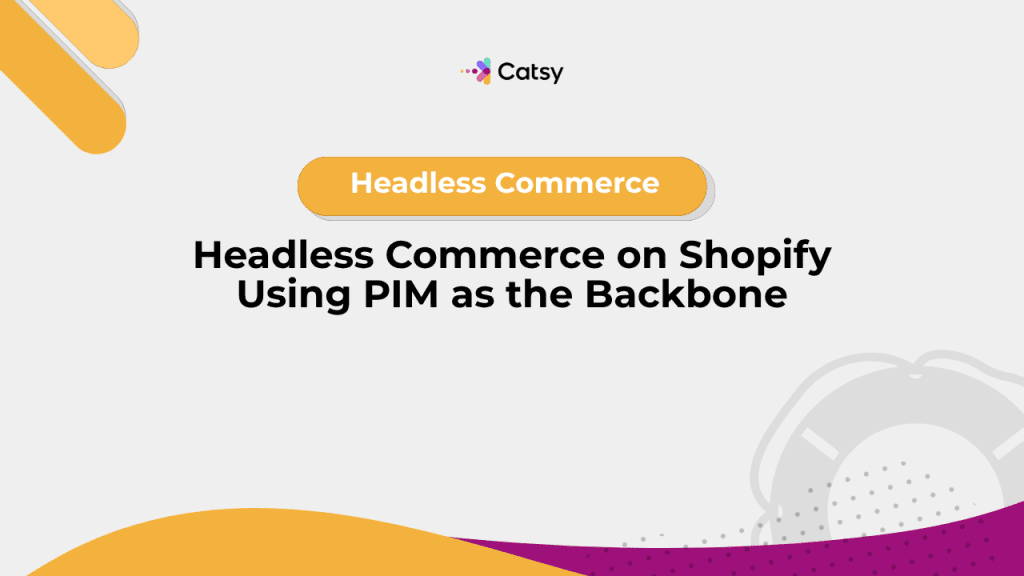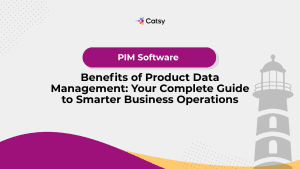Headless Commerce on Shopify Using PIM as the Backbone
Explore how PIM powers headless commerce for Shopify stores. Learn how to centralize content, drive flexibility, and scale product syndication.

Table of Contents
- Introduction: Setting Sail Toward Headless Commerce
- What Is Headless Commerce?
- Why Shopify Plus Merchants Are Embracing Headless
- The Role of PIM in Headless Commerce
- Headless Shopify + PIM: How It Works
- Benefits of a PIM-Powered Headless Architecture
- How Catsy Supports Headless Shopify
- Real-World Use Cases: From Fragmented to Unified
- Getting Started with Headless Shopify Using Catsy
- Conclusion: Plotting Your Course with Confidence
What You Will Learn
- The basics and benefits of headless commerce on Shopify
- How PIM software acts as a central data layer in a decoupled setup
- The technical and business advantages of integrating PIM with headless Shopify
- Real-world headless use cases for enterprise-scale sellers
- How Catsy empowers headless success through automation and syndication
In this Article
1. Introduction: Setting Sail Toward Headless Commerce
If your business is a ship sailing e-commerce seas, you may have noticed that digital business has entered unchartered waters. For Shopify Plus merchants, the traditional setup will no longer handle highly customized experiences and multi-channel flexibility.
Enter headless commerce.
In your journey to success, your product information management (PIM) system is your navigation center. It steers your data across multiple storefronts, APIs, and digital experiences.
Let’s dive into why a PIM powered headless setup is the future of Shopify, and how Catsy gives you the tools you need for a smooth voyage.
2. What Is Headless Commerce?
Headless commerce is an architectural approach. It involves decoupling the front end (the head) and backend (commerce logic and data). Rather than rely on huge platforms to do everything from management to distribution of your data, you use custom APIs to connect a custom front end to your backend services.
For a Shopify store, this means:
- Shopify handles your cart, checkout, and backend management
- A custom front end (for instance, Next.js, Vue, or React) handles the user experience
- APIs are used to bridge the two
This specific architecture unlocks flexibility and speed, but the master key is your data. You need a single source of truth to manage your product data.
That’s where a PIM system becomes essential.
Make Catsy DAM and PIM Software an Extension of Your Team
Book a Free Demo3. Why Shopify Plus Merchants Are Embracing Headless
Headless commerce isn’t just a fringe trend, it’s now a growing movement among enterprise businesses.
According to Shopify Plus, “headless commerce gives you the freedom to build customer experiences that convert, using the tools and frameworks you prefer.”
The reasons for this shift include:
- Performance: Static front ends built with JAMstack frameworks will load faster
- Omnichannel reach: APIs deliver content to web, mobile, marketplaces, and IoT
- Customization: Merchants can design without the limitations of Shopify themes
- Agility: Developers and marketers can work independently
However, to scale all this across hundreds or thousands of SKUs, you need structured, validated content at the heart.
4. The Role of PIM in Headless Commerce
In a headless Shopify setup, your product information management system is your central control tower. It organizes, enriches, and syndicates your content to various front ends and channels.
a. Centralizing Product Data
With Shopify split from the front end, you need a unified place to manage:
With Shopify separated from the front end, you need a unified place to manage your localized content, titles and descriptions, media files, and other essential data.
A PIM like Catsy ensures that your products display consistent, compliant information from a single dashboard.
b. Powering Multi-Channel Syndication
In headless commerce, your content may appear anywhere! You may be listing on custom web apps, social platforms, or even AR experiences. A robust PIM ensures that you can syndicate your product data to each of these customer touchpoints.
c. Feeding Front end Flexibility
Your developers may build one front end using React and another using Vue for international markets. Without a centralized source of data, updating your content can quickly become a bottleneck.
On the other hand, a PIM allows your front end team to simply pull what they need via structured APIs; the data is a current and accurate version.
5. Headless Shopify + PIM: How It Works
Let’s map out the architecture of headless Shopify.
- Shopify → Checkout, Cart, Inventory Management
- Catsy PIM → Product Content, DAM, Localization, Syndication
- Custom Front end → Built using React, Gatsby, or Hydrogen
- API Layer → Connects front end with both Shopify and Catsy
In this model:
- Marketers use Catsy to enrich and approve content
- Developers pull data from Catsy’s API into their custom frontend
- Shopify only handles transactional processes
This decoupled approach maximizes your control and scalability.
6. Benefits of a PIM-Powered Headless Architecture
a. Speed & Performance
Headless front ends are typically faster, as they usually serve statically generated pages or optimized single-page apps. But these gains in speed mean nothing if your product data loads in a slow or inconsistent way. A PIM ensures lightweight data feeds that match your front end performance goals.
b. Design & UX Flexibility
Headless allows your user experience team to design without the limitations of Shopify’s themes. PIM will add the content backbone. Each block, callout, or call to action can be dynamically populated from your PIM’s content library.
c. Localization at Scale
Are you planning to expand into global waters? A headless setup that’s paired with a PIM will let you manage multiple languages, regional imagery, and market-specific specs.
Catsy supports localized fields, translated assets, and multi-store syndication … all from one platform.
d. Developer Efficiency
When you implement PIM, your developers can stop waiting on spreadsheets. They get structured, validated JSON or GraphQL feeds that will plug directly into their workflow.
According to Contentful, “a well-structured PIM accelerates headless deployment by reducing reliance on dev teams for every content change.”
e. Future-Proofing the Tech Stack
Decoupling your product content from your CMS and commerce platforms gives you increased flexibility. Swap out front end frameworks or expand into new channels without re-entering product data. Just think – you could grow your strategy to include voice search or mobile apps seamlessly.
7. How Catsy Supports Headless Shopify
Catsy is built for Shopify merchants who wish to transition to a headless setup. Key features of the PIM include:
- Structured product content API for front end developers
- Built-in DAM with CDN-powered media delivery
- Shopify-native integrations for metafields, tags, variants, and pricing
- Multilingual support for headless international storefronts
- Custom workflows and automation for product onboarding
- Product readiness reporting to ensure only validated data gets syndicated
It doesn’t matter whether you’re building with Hydrogen, Next.js, or Due Storefront. Your product data will sail smoothly from backend to port.
8. Real-World Use Cases: From Fragmented to Unified
Use Case 1: International Multi-Site Launch
A Shopify Plus merchant wished to launch separate headless storefronts for the United States, United Kingdom, and European Union markets. Catsy enabled:
- Region-specific titles, descriptions, and tax details
- Localized imagery and translations
- Central management and syndication via API
Use Case 2: Replacing Shopify Themes with React Front end
Another merchant opted for a React front end for optimal performance. Catsy became the content hub, providing product JSON feeds via API and syncing checkout data back to Shopify.
Result: +38 percent faster page loads, +24 percent AOV in the first 60 days.
9. Getting Started with Headless Shopify Using Catsy
Already using Shopify Plus? Here’s how to get started with Catsy!
- Audit Your Product Data
Identify content gaps, inconsistent fields, and disconnected media libraries. - Centralize in Catsy
Import product data, digital assets, and localization variants into Catsy’s PIM software. - Build Your API Layer
Leverage Catsy’s GraphQL/REST APIs to connect with your headless front end. - Test & Iterate
Use preview capabilities to validate data flow, rendering, and performance. - Launch with Confidence Once everything is validated, go live and monitor performance and content accuracy in real-time.
10. Conclusion: Plotting Your Course with Confidence
Headless commerce isn’t just a trend, it’s a new direction for ambitious Shopify Plus merchants. But navigating this journey requires the right anchor.
Catsy gives you a powerful PIM software that keeps your product data structured, validated, and ready to scale. Whether you’re customizing storefronts, expanding internationally, or future-proofing your tech stack, Catsy ensures your ship won’t drift off course.
11. Key Takeaways
- Headless commerce separates front end presentation from Shopify’s commerce backend
- A PIM is essential for managing and distributing product content in headless architectures
- Catsy offers built-in DAM, localization, and syndication tools for Shopify headless setups
- Headless commerce improves speed, UX, and developer agility
- Merchants using PIM + headless see gains in flexibility, conversion, and scalability
Want more tips, tutorials, and insights on product content and e-commerce operations?
Stay connected. We post regularly to help brands like yours scale smarter.
Are You Ready To streamline your product content management?

12. Frequently Asked Questions
Headless commerce on Shopify separates the front end user interface from the backend platform using APIs, allowing for custom user experiences and faster performance.
Your PIM is the backbone of your product content. It centralizes your data and makes it accessible to multiple front ends through APIs.
Yep. Catsy offers structured APIs, Shopify integration, and localization tools to support complex headless configurations.
Absolutely! Catsy allows centralized content to be published to different Shopify storefronts, marketplaces, or apps with tailored rules. Product syndication that makes sense!
Yep again! Catsy supports localization, multi-language content, and asset management for multiple storefronts… all from one central platform.
Subscribe For More Content
Sign up for monthly tips on how to drive revenue with product content.




